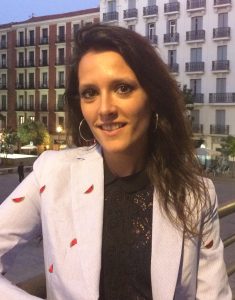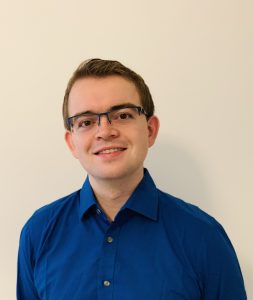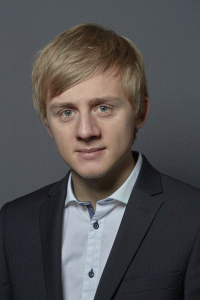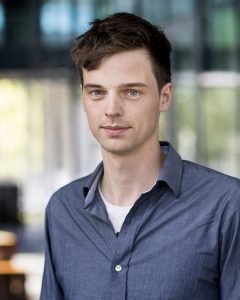Creating is Understanding: Synthetic Biology Masters Complexity – Best Poster Awards
The recent EMBO Workshop: Creating is Understanding: Synthetic Biology Masters Complexity (22 – 25 Sep) covered various themes that are geared toward basic research while being at the forefront of synthetic biology.
110 researchers came together at the EMBL Advanced Training Centre in Heidelberg, Germany for 3,5 days of talks, posters and networking. Here we present the work of 4 scientists who received best poster awards at the conference by popular vote.
Engineering portability of the CcaSR light switch for the control of biofilm formation in Pseudomonas putida

Authors: Angeles Hueso-Gil (1), Ákos Nyerges (2), Csaba Pál (2), Belén Calles (1), Victor de Lorenzo (1)
Two of the technical challenges faced by contemporary microbiology involve controlling gene expression using light and regulating bacterial biofilm formation, determined by the intracellular levels of the secondary messenger c-di-GMP. CcaSR system is one of the light switches repeatedly used for transcription induction in Escherichia coli. This two-component system represented a good candidate for its adaptation to Pseudomonas putida. Previous attempts have tried to use this microorganism as chassis for the implementation of new pathways, being biofilm formation an important function to control. To this end, we unified CcaSR components in one single construct and randomly mutagenized their regulatory regions to find a clone with a balanced expression of the system key parts inside P. putida. The combination of this novel mutagenization process with a proper screening, which included a first sorting of the libraries and the later isolation of colonies, lead us to a clone with a much improved induction by green light. The selected variant had a notable capacity in response to green light. Finally, optimized CcaSR was used to control the expression of super-efficient variant of PleD, a diguanylate cyclase of Caulobacter which allowed a tight control of c-di-GMP levels, and therefore, of biofilm production.
(1) National Centre for Biotechnology, Spain
(2) Biological Research Centre of the Hungarian Academy of Sciences, Hungary
Designer membraneless organelles enable orthogonal translation in eukaryotes

Christopher Reinkemeier (1,2,3), Gemma Estrada Girona (3), Edward A. Lemke (1,2,3)
Genetic code expansion is a powerful tool to study and control protein function with single-residue precision. It is widely used to e.g. perform labeling for microscopy or to photocontrol proteins. This is achieved by introducing an orthogonal tRNA/synthetase suppressor pair into the host, to recode a stop codon to incorporate a noncanonical amino acid (ncAA) into the nascent chain. This technique is codon-specific, but it cannot select specific mRNAs, so naturally occurring stop codons could be suppressed leading to potential interference with housekeeping translation. Nature avoids cross-talk between cellular processes by confining specific functions into organelles. We aimed to design an organelle dedicated to protein engineering, but as translation is a complex process requiring hundreds of factors to work together, membrane-encapsulation would not be feasible. Inspired by the concept of phase separation we hypothesized that such an organelle could instead be designed membraneless. Phase separation can generate high local concentrations of proteins and RNAs in cells and has recently gained attention owing to its role in the formation of specialized organelles such as nucleoli or stress granules. Despite being membraneless and constantly exchanging with the cytoplasm/nucleoplasm, these organelles still perform complex tasks, such as transcription. We combined phase separating proteins with microtubule motor proteins to generated orthogonally translating organelles in living cells that contain an RNA-targeting system, the stop codon suppression machinery and ribosomes. These large organelles enable site- and mRNA-specific ncAA incorporation, decoding one specific codon exclusively in the mRNA of choice. Our results demonstrate a simple yet effective approach to the generation of semi-synthetic eukaryotic cells containing artificial organelles to harbor two
distinct genetic codes, providing a route towards customized orthogonal translation and protein engineering.
(1) Johannes Gutenberg University Mainz, Germany
(2) Institute of Molecular Biology, Germany
(3) EMBL Heidelberg, Germany
Metabolic perceptrons for neural computing in biological systems

Amir Pandi (1), Mathilde Koch (1), Peter Voyvodic (2), Paul Soudier (1), Jerome Bonnet (2), Manish Kushwaha (1), Jean-Loup Faulon(1)
Synthetic biological circuits are promising tools for developing sophisticated systems for medical, industrial, and environmental applications. So far, circuit implementations commonly rely on gene expression regulation for information processing using digital logic. Here, we present a new approach for biological computation through metabolic circuits designed by computer-aided tools, implemented in both whole-cell and cell-free systems. We first combine metabolic transducers to build an analog adder, a device that sums up the concentrations of multiple input metabolites. Next, we build a weighted adder where the contributions of the different metabolites to the sum can be adjusted. Using a computational model fitted on experimental data, we finally implement two four-input of metabolite combinations by applying model-predicted weights to the metabolic perceptron. The perceptron-mediated neural computing introduced here lays the groundwork for more advanced metabolic circuits for rapid and scalable multiplex sensing.
(1) French National Institute of Agricultural Research, France
(2) INSERM, France
Programmed uptake of biomacromolecules into protocells

Wiggert Altenburg, Amy Yewdall, Daan Vervoort, Alex Mason, Jan van Hest
The bottom up recreation of cellular processes into synthetic compartments has, in recent years, emerged as an exciting line of research with which to study biological processes in a controlled environment. However, the interior of a living cell is a difficult milieu to mimic in bottom-up synthetic cells, as it is an environment crowded with high concentrations of many different biomacromolecules. In this work, we describe the development of a powerful new tool to more accurately emulate the cell cytosol in discrete coacervate-based protocells. The coacervate core utilized herein not only provides an inherently crowded and highly charged microenvironment, but has also been chemically modified to interact specifically with recombinantly expressed proteins. Our method leverages the well-established binding of His-tagged proteins to Ni2+-nitrilotriacetic acid, which ensures that macromolecules are taken up in a highly efficient, yet gentle manner, thus preserving biological activity. The straightforward method allowed for both control over the amount taken up and an increased local concentration. Moreover, the engineered uptake of proteins was then employed to study two key aspects: the effect of the Ni-NTA interaction on the diffusivity of incorporated proteins, and the enhancement in activity of an encapsulated two-enzyme cascade. This direct and targeted method of protein uptake into a discrete, membrane bound platform is a significant step forward for synthetic cells, and will enable the engineering of highly complex enzyme and signaling networks with increasingly life-like properties.
Poster currently not available
Eindhoven University of Technology, The Netherlands